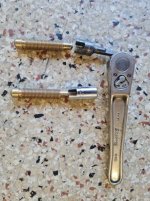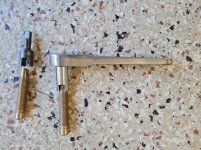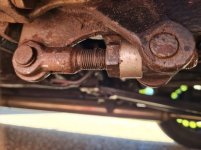Following on from the tread about braking that has helped others & myself immensely, but probably has outlived it's usefulness for now, I'll switch.
Not being an 'expert' but having dabbled in this area of the trade I'd like to learn from those who may be considered sporty or racing types who are 'much more expert' & here are some things I know & questions asking for comments & suggestions.
1. Tyre pressures, suspension wear & condition are critical to doing a wheel alignment job correctly.
2. Vehicle height & weight i.e. balance is extremely important in getting 'perfect brakes' & what I've been working on.
3. I know doing a corrective wheel alignment won't correct or even out tyre wear - so if toe or camber wear 'for examples' were present, replacing the tyre or tyres is the only real course of corrective action before doing an accurate wheel alignment.
BTW I don't have this issue tyres have done about 1200km & no feathering or obvious wear pattern.
4. I had the vehicle checked out & adjusted being told it was good for the track. Then checking again on a Brake Roller Test that it was not as good as I expected.
PLEASE this is not a criticism of anything that was done to the vehicle as it is getting better & better with everything that is being done.
It is in my nature to strive for perfection & not near enough.
As many watching this know about these BRT tests, they really tell the truth IMO & here is what they do:
"Brake Roller Testing is a service that safely measures the vehicle's braking system while stationary, using an automated weighing system which accurately calculates the braking efficiency. This method allows us to assess the braking force for each individual wheel and any imbalances across the axles, as well as the testing of emergency brakes and parking brakes without the risk of accident due to faults."
So with that & the last BRT after our field work, the heights of this Light 15's all are similarly 275mm within 2mm. The rear axle weight balance, brake readings & deceleration concern me ~ is any weight/alignment issue likely to be causing this ~ maybe front/rear axle distances, that should have been measured & may have been? - any feedback appreciated
Not being an 'expert' but having dabbled in this area of the trade I'd like to learn from those who may be considered sporty or racing types who are 'much more expert' & here are some things I know & questions asking for comments & suggestions.
1. Tyre pressures, suspension wear & condition are critical to doing a wheel alignment job correctly.
2. Vehicle height & weight i.e. balance is extremely important in getting 'perfect brakes' & what I've been working on.
3. I know doing a corrective wheel alignment won't correct or even out tyre wear - so if toe or camber wear 'for examples' were present, replacing the tyre or tyres is the only real course of corrective action before doing an accurate wheel alignment.
BTW I don't have this issue tyres have done about 1200km & no feathering or obvious wear pattern.
4. I had the vehicle checked out & adjusted being told it was good for the track. Then checking again on a Brake Roller Test that it was not as good as I expected.
PLEASE this is not a criticism of anything that was done to the vehicle as it is getting better & better with everything that is being done.
It is in my nature to strive for perfection & not near enough.
As many watching this know about these BRT tests, they really tell the truth IMO & here is what they do:
"Brake Roller Testing is a service that safely measures the vehicle's braking system while stationary, using an automated weighing system which accurately calculates the braking efficiency. This method allows us to assess the braking force for each individual wheel and any imbalances across the axles, as well as the testing of emergency brakes and parking brakes without the risk of accident due to faults."
So with that & the last BRT after our field work, the heights of this Light 15's all are similarly 275mm within 2mm. The rear axle weight balance, brake readings & deceleration concern me ~ is any weight/alignment issue likely to be causing this ~ maybe front/rear axle distances, that should have been measured & may have been? - any feedback appreciated
| AXLE | STATIC WEIGHT LHS T | STATIC WEIGHT RHS T | BRAKE FORCE LHS kN | BRAKE FORCE RHS kN | PEAK DECELERATION LHS %G | PEAK DECELERATION RHS %G | PEAK DECELERATION BALANCE % |
| FRONT | 0.30 | 0.30 | 1.4 | 1.5 | 47.6 | 51.0 | 93 |
| REAR | 0.25 | 0.30 | 0.9 | 0.6 | 36.7 | 20.4 | 55 |
| VEHICLE SERVICE BRAKES PEAK DECELERATION | 39%G |



